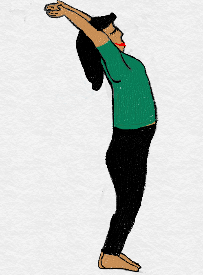|
A detailed view of back bend or hasta uttanasana
Modern day yogasana (karma) can be approached through “feel” (bhava) of movement or “technique” (Shastra -gnana) that is based on anatomy and biomechanical principles. No method is right or wrong and one may lie anywhere along the spectrum from totally feel based to totally technical and the myriad of ways in between. It is important to find your own niche for the best learning to happen. Go slow and figure out your own way…. and master it. This is no easy task, though it may sound like it….and when you are willing to “climb the ladder”, StableMovement PT is at hand. Yogasanas involve large movements to the end of range of motion and skillful movement beyond, promoting flexibility. Yet at the same time, for a safe and effective execution of the movement, necessitate biomechanical and muscular stability. These two acts are not mutually exclusive and actually happen synchronously for stable, smooth, and graceful execution. Back bend is one such posture that requires spinal, hip, and shoulder extension to end range, yet gently balancing the posterior weight shift (COG) on stable feet with effective dorsiflexor contraction throughout. Moving upwards from the ground (feet), the quadriceps need to be engaged distally by upward pull on the knee cap or patella. In order to deepen the pose, it is essential to relax the anterior chain of muscles including the hip flexors, abdominals, and pectorals. This relaxation is intermingled with synergistic lengthening (eccentric elongation) which must be slow and gradual to gain optimal extension. Breathing, slow and deep (diaphragmatic), is very effective during deliberate relaxation and eccentric elongation phases. The rectus femoris (two-joint quadriceps muscle) which is also a hip flexor must relax and lengthen proximally at the hip joint along with the iliopsoas and pectineus. The TFL and gluteus medius are engaged in mild contraction to maintain the in hip neutral (rotation) position. This allows the pelvis to rotate back on the femur and the extension of lumbar spine. The thoracic spine extension and rib cage lifting and opening is facilitated by relaxation and elongation of the obliques and rectus abdominus. The emphasis is on slow movement, thereby moving one vertebrae at a time during lumbar and thoracic extension, ensuring a uniform spinal curve instead of a hyper-mobile and hypo-mobile segment with a rib-thrust. The agonist muscles in a backbend are the hamstrings, gluteus maximus, spinal extensors, and the intercostals. Multiple muscles co-contract for scapular stability and to allow smooth glenohumeral (shoulder joint) mobility. Namely the serratus anterior, the trapezii, rhomboids, levator scapulae, and the rotator cuff muscles. The body is stable both dynamically, while moving for optimal range or flexibility, and at the end of movement, when static stability is imperative to maintain acquired position. This end range hold calls for gentle muscle contraction of the anterior chain muscles so that they co-contract with the agonist extensors for joint stability at the given alignment. This co-contraction and static stability produces a blissful experience of the end range (it is natural when observant) and thereby prevents stress on the joint surfaces and unnecessary strain of the ligaments.
0 Comments
Your comment will be posted after it is approved.
Leave a Reply. |
Details
AuthorAmi Gandhi is a licensed physical therapist in the state of California. She is the owner of StableMovement Physical Therapy, a small boutique practice in San Jose that offers patient centered, one-on-one, hands-on physical therapy. Archives
March 2018
Categories |
